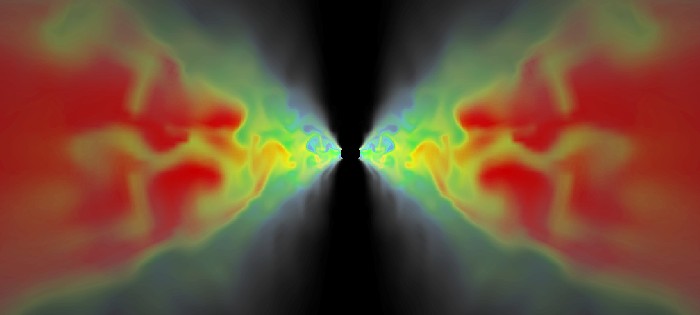Accretion onto Black Holes |
The presence of black holes in the Universe can be inferred from their gravitational influence on nearby stars and gas, or from the radiation that is emitted as gas captured by the hole falls in toward the event horizon. Using these techniques, astronomers have found strong evidence for both stellar mass black holes, with masses around 10 times that of the Sun, and supermassive holes in the centers of galaxies with masses that range from millions up to billions of solar masses. As gas is captured and spirals towards these holes, a process known as accretion, temperatures of millions of degrees can be attained. At these temperatures, the gas emits X-rays, which can be observed with X-ray observatories such as Chandra and XMM-Newton.
A major puzzle in black hole accretion lies in understanding why some sources containing black holes are extremely luminous while others are comparatively dim. For example quasars, supermassive black holes found in the centres of generally distant galaxies, are the most luminous steady sources of radiation in the Universe. By contrast, the black hole at the center of our own Milky Way galaxy, which has a mass of around two million solar masses, is swallowing gas from nearby massive stars yet emitting very little radiation. The most popular explanation for this quiescent mode of accretion is that the heated gas is simply unable to emit radiation quickly enough before vanishing from view across the event horizon of the black hole. Another, competing theory, suggests that the inflow is accompanied by a strong outflow, so that only a small fraction of the gas ever falls close enough to the black hole to be strongly heated and emit radiation.

|
| Figure 1: Results from a simulation of black hole accretion. The image shows a slice through the flow, which is concentrated towards the equatorial plane and rotating around the vertical axis. The image depicts the gas density, colour coded with the entropy to highlight the presence of convection in the disc. |
MPA researchers are studying whether observations can distinguish between these different theories. Figure 1 shows the results of a hydrodynamic simulation of gas which is unable to cool accreting onto a black hole. The gas forms a hot, thick disk rotating around the hole, with some material being blown off in the polar direction. Convection in the disk leads to large fluctuations in the density and temperature of the gas. We are currently working to calculate the predicted spectra of the (weak) radiation that would be emitted by such a disk, and how those spectra vary with time as a consequence of the hydrodynamic variability in the flow. Observations show that accreting black holes (and other objects surrounded by disks, such as neutron stars, white dwarfs and young stars) display variability across a wide range of timescales, and an important goal of research in this area is to understand the physical processes responsible for this variability.
Philip Armitage,
Kees Dullemond
Further information:
| MPA-Home |